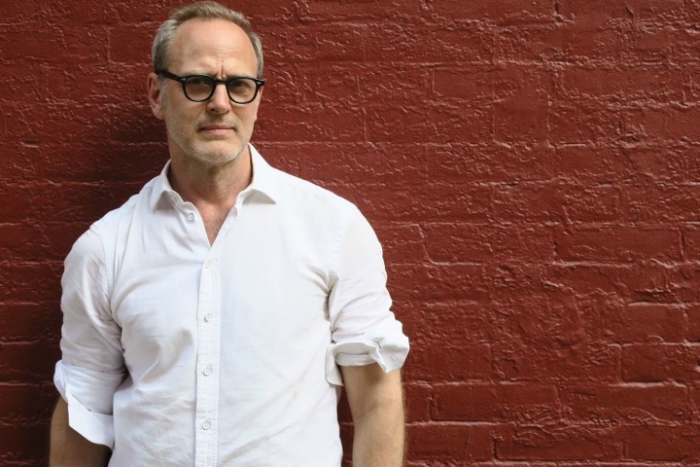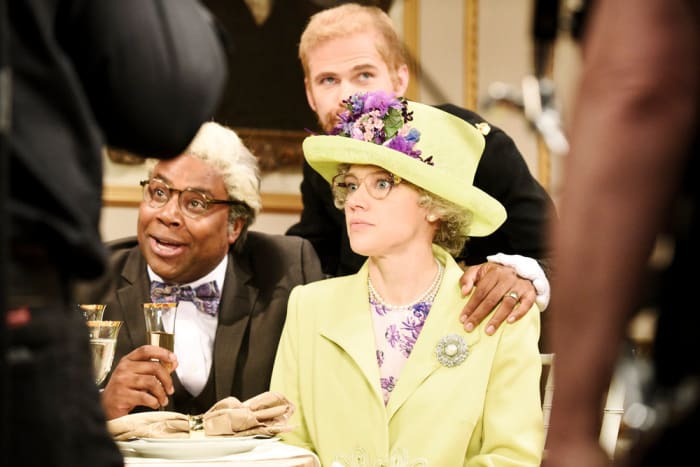HOW LONGTIME ‘SNL’ COSTUME DESIGNER TOM BROECKER BUILT A CAREER AT THE LEGENDARY SKETCH COMEDY SHOW
In our long-running series “How I’m Making It,” we talk to people making a living in the fashion and beauty industries about how they broke in and found success.
Of the four decades “Saturday Night Live” has been on the air, Tom Broecker has been firmly entrenched behind-the-scenes for nearly three of them. The legendary sketch comedy show’s chief costume designer began working at the program in his mid-20s, shortly after Executive Producer Lorne Michaels returned to it, following a brief hiatus in the early 1980s. Upon his homecoming, Michaels restaffed entirely, including the costume department; Broecker came on board at the recommendation of a friend, who herself had also just been hired.
In the grand scheme of Broecker’s career, the rest was basically history, but it wasn’t all a straight path to the role he holds now. Before putting in his first several years at “SNL,” Broecker was living and working in Los Angeles — “I became disillusioned with New York for a moment, so I went out to see what LA was like,” he tells me in a phone call — and initially left “SNL” after several years to broaden his education at the esteemed Yale Drama School. After graduation, Broecker found himself back at “SNL,” again at the endorsement of a friend and former colleague.
Throughout our conversation, Broecker is candid that his network has helped him succeed. (“Those are the kinds of friends you want,” he says. “They’re amazing designers and best friends. You never know where one thing is going to lead.”) But he also credits the incredibly fast-paced learning curve that he’s found to be unique to “SNL.” (He’s also costumed TV shows, like “30 Rock,” and stage productions, like Will Ferrell’s “You’re Welcome America” and David Mamet’s “Race.”) In the three days (or fewer) that the cast and crew has to put together a full show, there’s such constant rewriting and recasting that it forces one to learn not only how to work on the fly, but also to throw excuses out the window. Broecker specifically references the “Royal Wedding” sketch in this past season’s May 19 finale, in which the the team recreated all of the major looks from the Duke and Duchess of Sussex’s nuptials on Saturday morning in time for a show that same Saturday evening.
But before Broecker was leading the “SNL” costume department (alongside his co-designer, Eric Justian), he was a boy growing up in Indiana with scientific, not fashion, aspirations. That changed in high school, and that’s when the rest really was history. I spoke with him about all of that, from the most applicable lessons he learned while at Yale Drama School to his experiences of helping mold one of TV’s most significant programs. Read on for the highlights.
When, and where, did your interest in both fashion and costume design begin?
I was probably around six years old. My parents were divorced and I lived in Indiana with my mom at the time. When we came to visit my dad [in New York], it was a completely different world. I noticed people’s clothing and I noticed fashion.
There was a book I was given as a kid called, “My Book About Me.” It was a big book in the ’70s where you [filled in the blanks]. Where it said, “When I grow up,” I said I wanted to be a fashion designer. But then I have other books that have me practicing my handwriting that say “Dr. Broecker.” So, clearly, I was of two brains: one wanting to be a doctor and one wanting to be a fashion designer.
At what point did you realize design could actually become a career for you?
I put the fashion designer stuff aside for a very long time, thinking I wanted to be a doctor and child psychiatrist. Then in my sophomore year of college, I realized the world of science wasn’t calling me anymore; I didn’t want to spend my entire life in a lab and I was exploring the arts more. All of a sudden, I was like, “Oh, wait, I can have a career as a costume designer? This is actually a career?” After that, I started on this trajectory of art history, and costumes, and theater, and dance. Eventually, I came to the Juilliard School, where I was an intern, then worked in the industry for about five years in New York, then went to Yale Drama School, then came back [to New York]. I just started working, working, working.
What are some lessons you learned at Yale that are still relevant to what you do today?
Yale Drama School really taught me how to think like a designer: how to read a script and break it down and think conceptually, and then take those ideas and distill them down to each character — you know, doing an anthropological, sociological discipline of the world. You’re studying history. You’re studying the importance of language and how language influences a character’s motivation. It’s important to understand the text and how a character is built upon the text. All these things motivate what the character will wear.
What advice would you give to yourself when you first arrived in New York early in your career?
One thing I always tell people when they’re young is to say yes to everything, because you never know where or when or how it could lead to something else. It may not be evident in the moment; you may be working with someone and five years later, they have a new job, and they remember you, and they want to hire you.
Also, understanding how costumes work, how sets work — [how everything works] in the film industry. Understanding returns and budgets is really, really important. The part about working as a costume designer that you don’t learn in school is that you’re an independent business person, because you’re managing people. You’re managing money. And then you have this other part of the brain, the creative brain, and sometimes [those parts] fight each other. You may think, “I just want to deal with the artist part.” But part of the “artist part” is informed by the budget and how to work within it. Every job has a different budget. We all don’t get the budget we want, so we have to figure out how to manage money. There’s practical aspects to design, as well.
Once you were back in New York full-time, after Yale, how did the “SNL” opportunity come about?
I met a dear friend at Yale — we did theater together there — and then we were at Juilliard together as interns. I became disillusioned with New York for a moment, so I went out to Los Angeles to see what LA was like. This was the late ’80s and [Lorne Michaels] had just come back to “SNL.” A whole new staff had been hired and they hired a new costume designer. That costume designer hired my friend, Melina.
Melina gave me a call and said, “Hey, we’re looking for another person. You should come and join us.” So, I came back I worked for a couple years at “SNL” and then left to go to Yale Drama School. When I came back, Melina was designing the show and asked if I wanted to come back to “SNL.” I was like, “I’ve already done the show. Why do I want to come back to the show?” She goes, “I’m going to leave in a couple years and then you can take it over.” The rest was history.
In interviews, “SNL” alums have talked quite a bit about how incredibly nimble and hardworking the costume department is, and that you make things happen simply because they need to get done. Can you speak to that experience?
On some level, “SNL” has been the best schooling I’ve ever had in my entire life. It’s not for the faint of heart. You have to constantly be thinking on your feet, and you have to be able and willing to throw anything out at a moment’s notice and start over from scratch.
You have, more or less, three days to put a show together. Within those three days, there’s constant rewriting and recasting. You may start a sketch with [Keenan Thompson], so you design a costume for Keenan and work on it all day. But you may come into work on Friday and they’ve redone the sketch and recast a woman who’s a smaller size, so you have to be okay to throw that out and start over. You have to develop nerves of steel.
But the biggest thing you have to learn is how to trust yourself, your gut and your design, and understand that part of it is just experience, on some level. You get to a certain point where you understand your craft more. You understand how to get things done. Certainly, when you’re first starting out in your career, there’s many sleepless nights spent wondering, “How’s this all going to get done?” Please, there are many times, even to this day, that we’re like, “How are we going to get this done?”
Sometimes it spoils you, because you know what’s possible and you know things can happen really quickly; I know I have an amazing team who can get things done when the lead time is three days, versus, say, designing an opera, which is a year-and-a-half lead time. You think, “You want me to design this now? But in a year and a half, these aren’t going to be the clothes I want to put out there. I’ll have thought of something completely different. I’ll have made all new connections in the script.”

